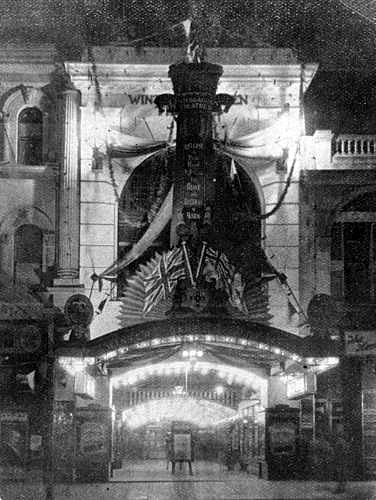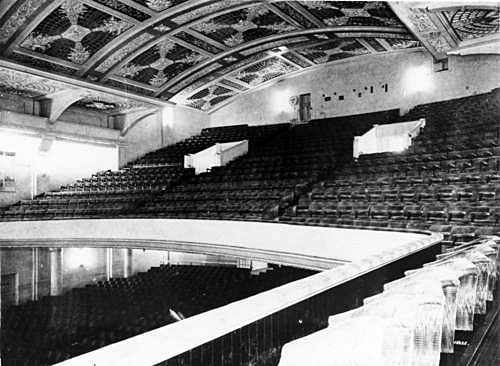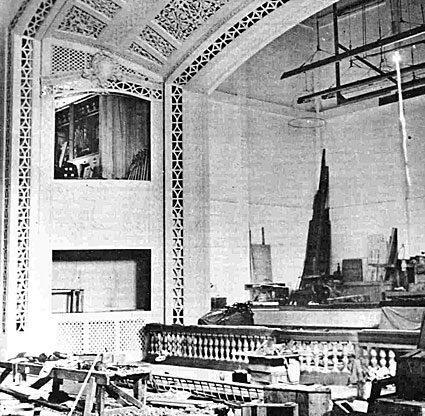
The Wintergarden Theatre, Brisbane, illuminated in 1927
for the visit of the Duke and Duchess of York
[Photograph: John Oxley Library, State Library of Queensland, Neg: 61680]

The Wintergarden Theatre, Brisbane, illuminated in 1927
for the visit of the Duke and Duchess of York
[Photograph: John Oxley Library, State Library of Queensland, Neg: 61680]
Historical and Technical Documentation by Geoffrey Cox
© OHTA 2012, 2016 (last updated May 2016)
Located in Queen Street, Brisbane, adjacent to His [later Her] Majesty's Theatre, the Wintergarden Theatre was designed by the architects Ballantyne & Hare in association with Hall & Prentice of Brisbane.1 When it opened on Friday 1 August 1924, the Wintergarden was hailed as one of the most modern theatres of its time:
WINTERGARDEN THEATRE OPENED
Public opinion, as represented by the very large gathering which assembled in the Wintergarden Theatre last evening, was entirely in accord with the claim that the new picture theatre is the finest and most artistically decorated in the Commonwealth. On the occasion of the official opening of the theatre by the Mayor of Brisbane (Alderman Maurice J. Barry) a large number of spectators were afforded an opportunity of enjoying an excellent and varied programme, and also of admiring the theatre and all the details of furnishing and equipment. From its spacious vestibule, bordered with attractive shop window displays, to the luxuriously carpeted rest rooms on the first floor, the new theatre has been planned and finished with the utmost care und artistic forethought, and the result is as near perfection as can reasonably be expected.2

Interior of the Wintergarden Theatre, c.1939
[Photograph: John Oxley Library, State Library of Queensland, Neg: 135056]
In advertisements for the opening entertainments, the description of the theatre included details of the musical facilities, including the theatre organ that had been installed:
A Theatre Designed for Queensland's Climate, with open sides and steel roller shutters, to open or close at will, thus providing the most ideal conditions under which to enjoy your amusement. . . .
The Decoration of the Theatre is in keeping with its Construction. The design on the magnificent ceiling is taken from Queensland Ferns and Plants.
The Biggest Theatre Organ in Australia, Costing £10,000, and representing an Orchestra of 100, which will alternate during performances with the Concert Orchestra of 20 Picked Artists.
America's Foremost Organist, Mr. Byron Hopper, Mus Bac., specially engaged, has just arrived per R.M.S. Makura from New York City, and will demonstrate this magnificent instrument.
Wintergarden Royal Concert Orchestra of 20 Performers, under the Baton of Mr. Haydn Beck, acknowledged as Australia's foremost conductor, and late of J. C. Williamson's Ltd., etc.
… A High-class Picture and Musical Entertainment. The Directors of the Wintergarden Theatre intend placing before Brisbane theatregoers the World's Greatest Pictures, Concert and Vaudeville Artists, regardless of expense.3
The opulence of the Wintergarden was to be exceeded some five years later with the opening of the nearby Regent Theatre. These were the only two city cinemas in Brisbane to include a theatre pipe organ, a more common phenomenon in their Sydney and Melbourne counterparts. Both organs were built by the Wurlitzer Co. of North Tonawanda, N.Y. in the USA, and both were installed in time for the openings of the respective theatres.
The Wintergarden instrument (Wurlitzer's Opus 748) was the smaller of the two, and the ninth Wurlitzer imported to Australia from the United States.4 It was installed by J.E. Dodd of Adelaide.5

Installation of the Wurlitzer organ at the Wintergarden Theatre,
showing the console covered at the left of the pit, and the roll-playing
unit in the centre of the orchestra pit
[Photograph: Vox (November 1971), cited at Ian McIver, Encyclopedia of Australian Theatre Organs]
Amongst the noteworthy features of the instrument at the time of its installation were the various percussion effects, and the use of electric action:
Experts were busy yesterday at the Wintergarden Theatre connecting up the most remarkable pipe organ that has ever been put together in Brisbane. A pipe organ! It is more than that; it will do many things that this colossus of instruments hitherto has not usually been called upon to do. It will play with a harp-like effect, blow an alarm syren, play castanets, produce the sounds of galloping horses and sleigh bells, ring chimes and do many other 'stunts'. The organ, which is built in on one side of the proscenium, is controlled from a double manual in the orchestra pit. The keys of this manual on depression release electric currents which, in turn, release the air power which operates the organ. The pipes range in size from one inch in length, with the diameter of a pencil, to giants through which a man's body could pass, and which stand sixteen feet high. A second instrument is placed ten feet above the ceiling in the centre of the auditorium for echo and celestial effects. All this contrivance is in charge of Mr Byron C. Hopper, of New York, a graduate of a Middle West University, who, sitting at the keyboard, can combine the variously-toned pipes in endless number by the outwardly simple process of pressing a piston with his thumb; or by pressing more heavily he may play a 'cello solo with some fingers, while a lighter pressure from others calls up the lighter voices of the accompanying instruments, and an accent on even a single note may be obtained by the pressure of a pedal.6
Another important feature of the instrument was the roll-playing unit placed in the centre of the pit. The roll-player was operated by one of the usherettes during performances at which an organist could not be present. It was able to play two rolls at any time, to avoid delays during re-winding. As the unit used ordinary player-piano rolls, which did not control the organ stops, it was equipped with stop-keys duplicating those on the main console.7 Some of these later found their way to other organs.8
Joe Whitehouse is reported to have said that
the double tracker bar roll player was a thorough menace and caused much heart burning and worry to Joe and the theatre management alike. The usherettes often neglected to close the machine and rats supplemented their daily diet with a fricassee of rubber tubing, laced with felt and machine oil.9
The instrument was described as a "Hope-Jones Unit Orchestra" built by Wurlitzer, and comprised seven ranks, spread over two manuals and pedals: Open Diapason (Diaphone Bass extended to 16ft), Bourdon, Salicional, Viole Céleste, Clarinet, Tuba Horn (extended to 16ft), and Vox Humana (in a special box), together with percussion.10
The Wintergarden organ has been identified as a slightly modified version of Wurlitzer's Style 185, which lacked the Tibias found in other models, and it was reportedly the last example of their Style 185 to be manufactured. Unusual features of the Brisbane instrument were the substitution of a Salicional for the more usual Viol d'Orchestre, and the enclosure of the Vox Humana rank (and various percussion effects) in a separate 'echo' chamber above the proscenium arch.11
The complete stop list was recorded by Edward Salisbury in abbreviated form, and can be reconstructed with full names as follows:
SOLO |
(upper keyboard) 16 16 16 16 8 8 8 8 8 8 4 4 4 4 4 2-2/3 2 1-3/5 |
||
ACCOMPANIMENT |
(lower keyboard) 16 16 8 8 8 8 8 8 4 4 2-2/3 2 |
||
| ECHO SOLO Vox Humana Cathedral Chimes Sleigh Bells Glockenspiel Chrysoglott |
8 |
||
SOLO |
2nd TOUCH 16 (or 8) 8 |
||
ECHO ACCOMPANIMENT |
(lower manual) 16 8 4 |
||
| ACCOMPANIMENT Tuba Horn Clarinet Snare Drum Triangle Xylophone |
2nd TOUCH 8 8 |
||
PEDAL |
16 16 16 8 8 8 8 8 4 |
||
EFFECTS |
(by foot pistons) |
||
| ACCESSORIES Tremulant - Main Organ Tremulant - Tuba Horn Tremulant - Vox Humana Balanced swell pedal - Main Balanced swell pedal - Echo 3 foot pistons to Pedal 10 ? pistons to each keyboard Full Organ Pedal Full Traps Pedal.12 |
(all adjustable) 1 |

Interior of the Wintergarden Theatre in 1924
showing the organ console on the right, and the roll-playing unit in the centre
[Photograph: Ross Thorne, Picture Palace Architecture in Australia (South Melbourne: Sun Books, 1976),
cited at Ian McIver, Encyclopedia of Australian Theatre Organs]
The console appears to have been located originally on the right, in front of the orchestra pit. In October 1929, Whitehouse Bros were engaged to move it to a new position,13 which was recessed half-way up the right-hand proscenium splay wall, immediately opposite the main pipe chamber on the left.14 The Whitehouse firm was involved in maintaining the instrument throughout its time at the theatre. Amongst the work listed in their records, they undertook 'alterations and repairs' in December 1931 at a cost of £167.9.8, and in June 1932 they were responsible for 'converting Solo Chimes to Accompaniment second touch.'15 The console was reportedly re-located to the centre of the orchestra pit after 1932, when the orchestra was disbanded.16
This was the first 'extension' organ in Brisbane, and the first to use electro-pneumatic action. The association of Whitehouse Bros with this instrument, and with the one at the Regent Theatre, undoubtedly influenced the development of their own electro-pneumatic extension organs from 1932 onwards. The first of these was at St Andrew's Presbyterian Church, Bundaberg.
The use of the organ at the Wintergarden was discontinued in 1935,17 and the entire instrument was dismantled and packed by Whitehouse Bros in December 1937.18 It was removed initially to the Plaza Theatre in Sydney, where a set of Dodd Tibias was added. This instrument subsequently travelled (in increasingly enlarged form) to other locations in Sydney, Darwin and Adelaide, where it now forms the basis of the organ in the Capri Theatre, Goodwood. The original console was eventually utilised in a house organ owned by Mr Cec. Taylor of Sydney.19
The Wintergarden continued as a cinema until December 1973 and the auditorium was demolished in 1981. The site is now part of the Wintergarden Centre.20
Further details of this instrument can be found at Ian McIver's Encyclopaedia of Australian Theatre Organs.
______________________________________________________________________
1 Fryer Library Theatre Programs, University of Queensland: Winter Garden Theatre, FTPF52.
2 The Brisbane Courier (2 August 1924), p. 23.
3 The Brisbane Courier (31 July 1924), p. 3; The Brisbane Courier (2 August 1924), p. 9.
4 Vox (November 1971), p. 3.
5 OHTA News, vol. 5, no. 2 (April 1981), p. 19.
6 The Brisbane Courier (31 July 1924), p. 7.
7 Ian McIver, Encyclopedia of Australian Theatre Organs.
8 See, for example: Anglican Church Grammar School, East Brisbane, and East Brisbane, Mowbraytown Presbyterian Church.
9 Gordon Berry, 'Brisbane and its Theatre Organs: Part 1, 'The Wintergarden' and the Hope –Jones Orchestra Unit,' The Diaphone, vol. 5, no. 3 (July 1967).
10 Specification from Notebooks of Edward R. Salisbury (n.d.)
11 McIver, op. cit.
12 Specification from Notebooks of Edward R. Salisbury (n.d.)
13 Whitehouse Bros Ledger (1922-1940), p. 333.
14 McIver, op. cit.
15 Whitehouse Bros Ledger (1922-1940), pp. 529, 545.
16 McIver, op. cit.
17 McIver, op. cit.
18 Whitehouse Bros Ledger (1922-1940), p. 559.
19 Vox (November 1971), p. 3; The Organ Voice, vol. 25, no. 4 (December 1999), p. 18.
20 Fryer Library Theatre Programs, University of Queensland:
Winter Garden Theatre, FTPF52.